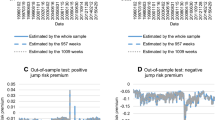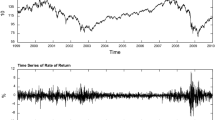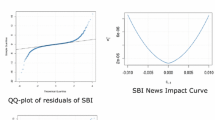Abstract
The nonparametric jump risk measures are sometimes difficult to construct using only the daily closing quotes and prices of short-dated and deep-out-of-the-money options. In this case, a time-varying shape parameter of risk-neutral jump tails in asset returns is usually assumed to be constant from week to week, in order to mitigate the impact of noise. In this context, this study proposes a method for measuring the daily option-implied jump tail risks. We use high-frequency options data with a data cleaning process, which relaxes the constancy assumption to more general cases such that the shape parameter can change at a daily frequency. We also apply the proposed daily tail measure to the high-frequency data of Nikkei 225 options. The results confirm the coherence of the daily tail risk measure with the existing measures but reveal relatively large spikes on particular days during the week associated with the tail events. To demonstrate the usefulness of the proposed measure, we empirically analyze the short-term predictability of the variance risk premium (VRP). The analyses suggest that the daily tail risk measure, which is a jump tail risk component of \({\textit{VRP}}\), has a significant predictive power for future \({\textit{VRP}}\) and that the inclusion of the diffusive and jump risk components of \({\textit{VRP}}\) as separate predictors improves the forecasting accuracy.



Similar content being viewed by others
Notes
The parameter estimates of \(\alpha ^{+}_t\) and \(\phi ^{+}_t\) for the right jump tails in Eq. (7) are obtained as
$$\begin{aligned} {\hat{\alpha }}^{+}_t&= \mathop {\mathrm{arg\,min}}\limits _{\alpha ^{+}} \frac{1}{N^{+}_t} \sum ^{N^{+}_t}_{i=2} \left| \text {log} \left( \frac{O_{t,\tau }(k_{t,i})}{O_{t,\tau }(k_{t,i-1})} \right) (k_{t,i} - k_{t,i-1})^{-1} - \, (1 + (-\alpha ^{+}) )\right| , \end{aligned}$$(11)$$\begin{aligned} {\hat{\phi }}^{+}_t&= \mathop {\mathrm{arg\,min}}\limits _{\phi ^{+}} \frac{1}{N^{+}_t} \sum ^{N^{+}_t}_{i=2} \biggr |\text {log} \left( \frac{e^{r_{t}\tau }O_{t,\tau }(k_{t,i})}{\tau F_{t,\tau }} \right) - (1 - {\hat{\alpha }}^{+}_t ) k_{t,i} + \text {log} ({\hat{\alpha }}^{+}_t - 1) + \text {log} ({\hat{\alpha }}^{+}_t ) - \text {log} (\phi ^{+}) \biggr |. \end{aligned}$$(12)In case of the right jump tails, \(O_{t,\tau }(k_{t,i})\) corresponds to OTM call option price or mid-quote for i-th log-moneyness \(k_{t,i}\) and \(N^{+}_t\) is the number of puts used in estimation with moneyness \(0< k_{t,1}< \cdots < k_{t,N^{+}_t}\). Then, the right jump tail variation is expressed as
$$\begin{aligned} {\textit{RJV}}^{{\mathbb {Q}}}_{t,\tau } = \tau \phi ^{+}_t e^{-\alpha ^+_t |k_t|} ( \alpha ^{+}_t k_{t} (\alpha ^{+}_t k_t + 2) +2 ) / (\alpha ^{+}_t)^3 = {{\mathbb {E}}}^{{\mathbb {Q}}}_t [{\textit{RJV}}^{\mathbb Q}_{t,\tau }]. \end{aligned}$$(13)The average number of \(N^-_t\) for the estimation of daily \(\alpha ^-_t\) based on the cleaned deep OTM put options data at the 10–30 min intervals is 178, and the corresponding 25% and 75% empirical quantiles are 104 and 228 in our sample period. They are more than the average number being 45 in Table 2 of Andersen et al. (2021) for the estimation of weekly \(\alpha ^-_t\) based on the daily deep OTM options data. Overall, our sample provides an alternative basis for the computation of the option-implied left jump variation.
We obtain one estimated value of \(\alpha ^{-}_t\) within the day by keeping the mid-quotes from the 14 intradaily intervals for the day. After that, we estimate \(\phi ^{-}_t\) and calculate \({\textit{LJV}}\) for each intradaily interval. Thus, we investigate whether there is a periodicity pattern in \(\phi ^{-}_t\) and \({\textit{LJV}}\) or not. We find that \(\phi ^{-}_t\) and \({\textit{LJV}}\) do not exhibit a remarkable pattern such as well-observed U-shaped intraday periodicity in asset return volatility in financial markets.
We also compute weekly \({\textit{LJV}}\) measures by averaging the daily measures constructed from high-frequency options data within the week. The sample cross-correlation versus the existing measure of weekly \({\textit{LJV}}\) in Andersen et al. (2021) is 0.88.
Using the implied left jump variation, Ubukata (2019) investigates its predictive ability for credit spreads in the US and Japanese corporate bond markets. They find that it could strongly predict lower-rated credit spreads and default spreads in Japan, even when controlled for the traditional predictors and lagged credit spreads, though it might be a weaker predictor of the US credit spreads.
References
Andersen TG, Bollerslev T (1998) Answering the skeptics: yes, standard volatility models do provide accurate forecasts. Int Econ Rev 39:885–905
Andersen TG, Bollerslev T, Diebold FX (2007) Roughing it up: Including jump components in the measurement, modeling, and forecasting of return volatility. Rev Econ Stat 89:701–720
Andersen TG, Bollerslev T, Diebold FX, Ebens H (2001) The distribution of realized stock return volatility. J Financial Econ 61:43–76
Andersen TG, Fusari N, Todorov V (2015) The risk premia embedded in index options. J Financial Econ 117:558–584
Andersen TG, Fusari N, Todorov V (2020) The pricing of tail risk and the equity premium: evidence from international option markets. J Bus Econ Stat 38:662–678
Andersen TG, Todorov V, Ubukata M (2021) Tail risk and return predictability for the Japanese equity market. J Econom 222:344–363
Bandi FM, Russell JR (2008) Microstructure noise, realized variance, and optimal sampling. Rev Econ Stud 75:339–369
Barndorff-Nielsen OE, Shephard N (2006) Econometrics of testing for jumps in financial economics using bipower variation. J Financial Econom 4:1–30
Barndorff-Nielsen OE, Hansen PR, Lunde A, Shephard N (2011) Multivariate realised kernels: consistent positive semi-definite estimators of the covariation of equity prices with noise and non-synchronous trading. J Econom 162:149–169
Barro RJ (2006) Rare disasters and asset markets in the twentieth century. Q J Econ 121:823–866
Bekaert G, Hoerova M (2014) The VIX, the variance premium and stock market volatility. J Econom 183:181–192
Bollerslev T, Todorov V (2011) Tails, fears and risk premia. J Finance 66:2165–2211
Bollerslev T, Todorov V (2014) Time-varying jump tails. J Econom 183:168–180
Bollerslev T, Tauchen G, Zhou H (2009) Expected stock returns and variance risk premia. Rev Financial Stud 22:4463–4492
Bollerslev T, Marrone J, Xu L, Zhou H (2014) Stock return predictability and variance risk premia: statistical inference and international evidence. J Financial Quant Anal 49:633–661
Bollerslev T, Todorov V, Xu L (2015) Tail risk premia and return predictability. J Financial Econ 118:113–134
Campbell JY, Lo AW, MacKinlay AC (1997) The econometrics of financial markets. Princeton University Press, Princeton
Chordia T, Roll R, Subrahmanyam A (2005) Evidence on the speed of convergence to market efficiency. J Financial Econ 76:271–292
Corsi F (2009) A simple approximate long-memory model of realized volatility. J Financial Econom 7:174–196
Drechsler I, Yaron A (2011) What’s vol got to do with it? Rev Financial Stud 24:1–45
Farhi E, Gabaix X (2016) Rare disasters and exchange rates. Q J Econ 131:1–52
Fukasawa M, Ishida I, Maghrebi N, Oya K, Ubukata M, Yamazaki K (2011) Model-free implied volatility: from surface to index. Int J Theor Appl Finance 14:433–463
Gabaix X (2012) Variable rare disasters: an exactly solved framework for ten puzzles in macro-finance. Q J Econ 127:645–700
Gao GP, Lu X, Song Z (2019) Tail risk concerns everywhere. Manag Sci 65:3111–3130
Hansen PR, Lunde A, Nason JM (2011) The model confidence set. Econometrica 79:453–497
Harris L (1990) Estimation of stock price variances and serial covariances from discrete observations. J Financial Quant Anal 25:291–306
Huang X, Tauchen G (2005) The relative contribution of jumps to total price variance. J Financial Econom 3:456–499
Leone V, Kwabi F (2019) High frequency trading, price discovery and market efficiency in the FTSE100. Econ Lett 181:174–177
Londono JM (2011) The variance risk premium around the world. International Finance Discussion Papers, Number1035, Board of Governors of the Federal Reserve System
Patton AJ (2011) Volatility forecast comparison using imperfect volatility proxies. J Econom 160:246–256
Rietz TA (1988) The equity risk premium: a solution. J Monet Econ 22:117–131
Roll R (1984) A simple implicit measure of the effective bid-ask spread in an efficient market. J Finance 39:1127–1139
Ubukata M (2019) Jump tail risk premium and predicting US and Japanese credit spreads. Empir Econ 57:79–104
Ubukata M, Oya K (2009) Estimation and testing for dependence in market microstructure noise. J Financial Econ 7:106–151
Ubukata M, Watanabe T (2014) Market variance risk premiums in Japan for asset predictability. Empir Econ 47:169–198
Acknowledgements
This work is supported by financial support from Grants-in-Aid for Scientific Research 18K01690 and 20H00073. We thank the Editor, Bertrand Candelon, and the anonymous referee for many suggestions that significantly improved the paper. The author thanks participants at the 6th Hitotsubashi Summer Institute (HSI2020) at Hitotsubashi University, October 2020, and the 4th International Conference on Econometrics and Statistics (EcoSta 2021) at the Hong Kong University of Science and Technology, June 2021, for useful comments.
Author information
Authors and Affiliations
Corresponding author
Ethics declarations
Conflict of interest
The author declares that they have no conflict of interest.
Ethical approval
This article does not contain any studies with human participants or animals performed by any of the author.
Additional information
Publisher's Note
Springer Nature remains neutral with regard to jurisdictional claims in published maps and institutional affiliations.
Rights and permissions
About this article
Cite this article
Ubukata, M. A time-varying jump tail risk measure using high-frequency options data. Empir Econ 63, 2633–2653 (2022). https://doi.org/10.1007/s00181-022-02209-5
Received:
Accepted:
Published:
Issue Date:
DOI: https://doi.org/10.1007/s00181-022-02209-5




